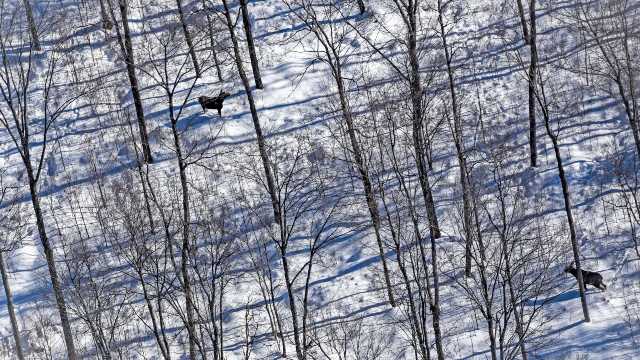In a recent survey presented to the Michigan Natural Resources Commission, it was revealed that the moose population estimate for the western Upper Peninsula shows no significant difference compared to the last survey conducted in 2019.
Since 1997, the Michigan Department of Natural Resources (DNR) has been diligently monitoring the core moose population in the western U.P., typically conducting surveys every other winter. The 2023 survey is particularly significant as it is the first survey completed since 2019, as the COVID-19 pandemic had caused scheduling conflicts.
Tyler Petroelje, a wildlife research specialist with the Michigan Department of Natural Resources in Marquette, reported, “The 2023 moose survey estimate was 426 individuals, which is not statistically different from the 2019 estimate of 509 individuals. This indicates a continuation of the trend of stable abundance, with a population growth of less than 1% over the past 12 years.”
The aerial moose surveys, conducted during winter over core moose habitat areas, involve identifying and counting bulls, cows, and calves. The most recent survey was carried out by the DNR between January and February of this year.
Covering approximately 1,400 square miles in parts of Marquette, Baraga, and Iron counties, the western U.P. moose core range is the result of translocation efforts from Canada in 1985 and 1987.
While the western U.P. is surveyed for moose, the remainder of the U.P. is not, although pockets of higher quality habitat in the eastern U.P. region do support a smaller moose population dating back to the 1950s.
During the 2023 winter survey, a total of 212 individual moose were tallied, representing a 20% decrease compared to the 266 moose observed in the 2019 survey. The point estimate indicates a 16% decline in moose abundance.
Petroelje commented, “Upon examining the demographic data from previous surveys, we observed a relatively low cow-to-calf ratio and calf numbers. Of concern is the reduced percentage of twins observed in this survey (9%), compared to the 10-year average of 15%.”
The decline in twins, coupled with a lower bull-to-cow ratio, may indicate a potential recruitment issue, referring to the number of individuals added to the population through births or immigration. DNR wildlife biologists will continue to closely monitor recruitment during future surveys to ascertain if a trend is emerging or if 2023 was simply a year with low calf numbers.
Another contributing factor affecting the moose population in the western U.P. is the high number of moose-vehicle collisions experienced in 2022. John Pepin, the DNR deputy public information officer in Marquette, cautioned, “Last year alone, at least 20 moose were involved in collisions in the western U.P. We urge motorists to exercise caution, especially during nighttime travel.”
Considering the Moose Hunting Advisory Council’s recommendation to implement a moose hunting season only if a growth rate exceeding 3% is maintained, the DNR is currently not proposing a hunting season. This aligns with the decisions made in previous years based on survey results.
The Michigan Department of Natural Resources remains committed to the ongoing monitoring and conservation efforts aimed at preserving the moose population in the western Upper Peninsula.







